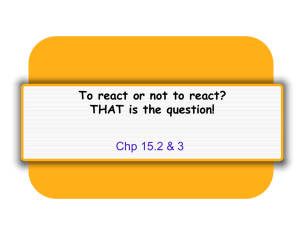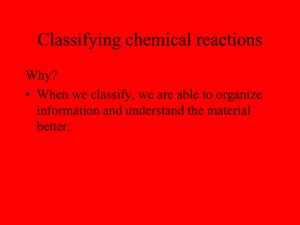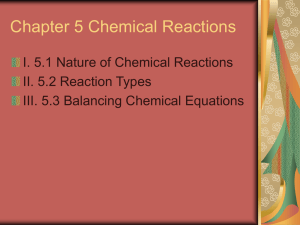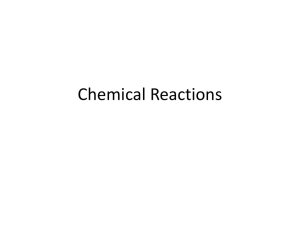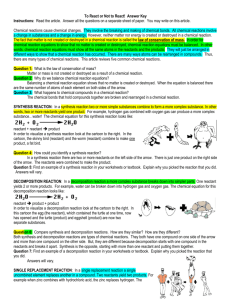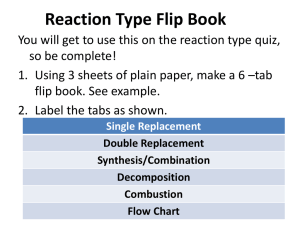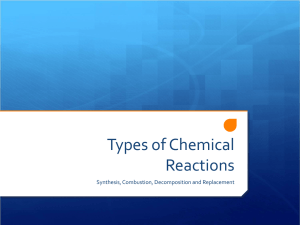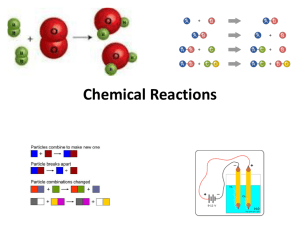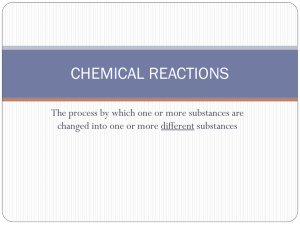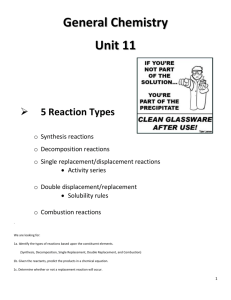Document
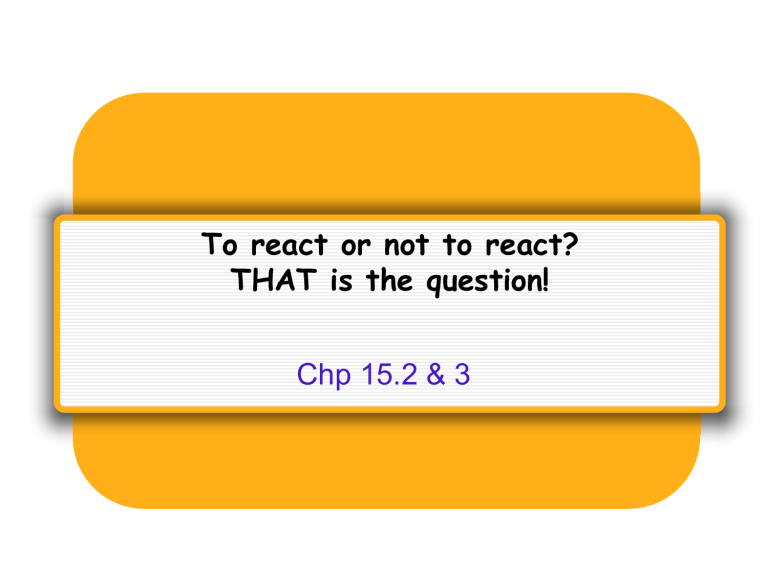
To react or not to react?
THAT is the question!
Chp 15.2 & 3
• Chemical changes are a result of chemical reactions.
• All chemical reactions involve a change in substances and a change in energy.
• Neither matter or energy is created or destroyed in a chemical reaction---only changed.
• There are so many chemical reactions that it is helpful to classify them into 5 general types:
Types of Reactions
• Synthesis: A + B -> AB
• Decomposition: AB -> A + B
• Single Replacement: A + BC -> AC + B
• Double Replacement: AB + CD -> AD + CB
• Combustion:
• Here is a short explanation and examples of each type of reaction
4. 5 types of chemical reactions
QuickTime™ and a
decompressor are needed to see this picture.
Diatomic Elements Info!
• Diatomic elements are nonmetal elements that form a covalent bond between two atoms.
• The diatomic elements are: hydrogen, nitrogen, oxygen, fluorine, chlorine, bromine and iodine.
• They always travel in pairs of atoms and therefore you must write then as:
• H
2
N
2
O
2
F
2
Cl
2
Br
2 and I
2
1. Synthesis
(Composition)
• In a synthesis reaction (also known as a composition reaction), two or more simple substances combine to form a more complex substance.
• Two or more reactants yielding one product is another way to identify a synthesis reaction.
• In the simplest type of synthesis reaction, two elements combine to form a
compound.
1. Synthesis Examples
• Hydrogen + oxygen yields water
:
2H
2
+ O
2
-> 2H
2
• Magnesium + nitrogen yields magnesium nitride 3Mg + N
O
2
-> Mg
3
N
2
• Iron + sulfur yields iron(II) sulfide
Fe + S -> FeS
• Barium + phosphorus yields barium phosphide
3Ba + P -> Ba
3
P
1. Synthesis
• The chemical equation for a synthesis reaction looks like:
• reactant + reactant -------> product
#1. Synthesis Summary
Definition
Two or more substances combine to form a new substance
Equation A + B --> AB
Looks
Like
Example 4Fe + 3O
2
--> 2Fe
2
O
3
Extra Info
Also called composition & addition reactions
2.
Decomposition
• In a decomposition reaction, a larger substance breaks apart and forms two or more simpler substances.
2.
Decomposition
• The first thing you may notice about a decomposition reaction is that it is the complete opposite of a synthesis reaction.
• In fact many synthesis reactions can be reversed into a decomposition reaction.
• When you burn hydrogen gas, the hydrogen combines with oxygen to produce water.
2.
Decomposition
• 2H
2
+ O
2
-> 2H
2
O
Synthesis Reaction
• With an electrical current, water can be decomposed into hydrogen and oxygen gas.
• 2H
2
O -> 2H + O
Decomposition
Reaction
2
2.
Decomposition
• For example, water can be broken down into hydrogen gas and oxygen gas.
• The chemical equation for this decomposition reaction looks like:
• reactant -------> product + product
2. Decomposition Summary
Definition
A single compound is broken down into two or more smaller compounds
Equation AB --> A + B
Looks
Like
Example H
2
CO
3
--> H
2
O + CO
2
Extra Info
Large compounds can also decompose into several other compounds.
3.
Single Replacement
• In a single replacement reaction a single uncombined element replaces another in a compound.
• Two reactants yield two products.
• For example when zinc combines with hydrochloric acid, the zinc replaces hydrogen.
3. Single Replacement
• The chemical equation for this single replacement reaction looks like:
• reactant + reactant---> product + product
• In a single replacement reaction, a more active element replaces a less active element in a compound.
3. Single Replacement
• Generally, as you go across the periodic table (from I-A to IIIV-A) metals become less chemically active.
• A metal such as magnesium is more chemically active that transition metals such as copper, tin or zinc.
• An easier way to identify the activity of element is to use an activity series which shows the chemical activity of both metals and nonmetals.
#3. Single-Replacement
Definition
One element replaces a similar element in a compound.
Equation AB + C --> AC + B
Looks
Like
Example 2HCl + Zn --> ZnCl
2
+ H
2
Extra Info
Here, more-reactive elements replace less-reactive ones - so sometimes it is impossible to reverse this reaction.
4. Double Replacement
• In a double replacement reaction, two metal ions (in aqueous compounds) switch places.
4. Double Replacement
• In a double replacement reaction parts of two compounds switch places to form two new compounds.
• Two reactants yield two products.
• For example when silver nitrate combines with sodium chloride, two new compounds--silver chloride and sodium nitrate are formed because the sodium and silver switched places.
4.Double Replacement
• The chemical equation for this double replacement reaction looks like:
• reactant + reactant ----> product + product
• One of the products is insoluble and forms a solid.
• This solid, called a precipitate, is more dense than the surrounding solution and falls to the bottom of the test tube.
• An arrow down is used to identify a precipitate
(because the precipitate sinks)
4.Double Replacement
• In a reaction between sodium chloride solution
NaCl (aq) and silver nitrate solution AgNO
3
(aq) the products are sodium nitrate
• NaNO
3
(s).
(aq) solution and silver chloride solid AgCl
4.Double Replacement
• Since silver chloride is insoluble (won't dissolve in water) it forms a white solid and sinks to the bottom of the test tube.
4.Double Replacement
• A solid that forms in a double replacement reaction is called a precipitate.
Here is a photo of this reaction:
#4. Double-Replacement
Definition
Ions in two compounds switch places.
Equation AB + CD --> AC + BD
Looks
Like
Example NaCl + AgNO
3
--> NaNO
3
+ AgCl
Extra Info
Often, a solid combines with a liquid & forms a precipitate in this reaction.
Combustion
• Combustion or burning is the sequence of exothermic chemical reactions between a fuel and an oxidant accompanied by the production of heat and conversion of chemical species.
• The release of heat can result in the production of light in the form of either glowing or a flame.
• Fuels of interest often include organic compounds (especially hydrocarbons) in the gas, liquid or solid phase.
#5. Combustion
Definition
A complex series of exothermic reactions between fuel & oxygen which produces energy.
Equation Fuel + Oxygen -(heat) --> Energy
Looks
Like
Fire!! (Brain Pop)
Example CH
4
+ 2O
2
→ CO
2
+ 2H
2
O + energy
Extra Info
Cars are powered by a combustion reaction which uses petroleum.
5. Types of Reactions Summary
QuickTime™ and a
decompressor are needed to see this picture.
Energy & Rates of
Chemical Reactions
Chapter 15 Section 3
CHEMICAL REACTIONS
& Energy
• If you’ve every sat by a warm campfire or in front of a stove, you’ve experienced heat from a chemical reaction.
• Burning is a chemical reaction that gives off or releases energy in the form of heat
& light.
• In plants,photosynthesis uses or absorbs energy from sunlight.
• In fact, all chemical reactions involve energy
Two Types of Reactions :
• Energy is involved in chemical reactions in two ways.
• 1. At the start of a chemical reaction, some
(or all) bonds between atoms in the reactants must be broken so that the atoms are available to form new bonds.
• 2. Energy is released when new bonds form as the atoms recombine into the new compounds of the products
• We classify chemical reactions based on how
(1) energy used in
(2) compares to energy released in
Type #1: Exothermic
• If forming new bonds releases more energy than it takes to break the old bonds, the reaction is exothermic.
• Exo means “go out” or “exit” and thermic means
“heat” or “energy”. If energy/heat is released, the reaction feels hot.
• A good example is the burning of hydrogen in oxygen
Type #2: Endothermic
• If forming new bonds in the products releases less energy than it took to break the original bonds in the reactants, the reaction is endothermic.
• Endothermic reactions absorb or use energy.
• Endo- means “go in” or “into”. If energy is absorbed, the reaction may feel cold. An example of an important endothermic reaction is photosynthesis.
Review:THE 4 RULES OF
CHEMICAL REACTIONS
• 1. Chemical reactions are processes in which atoms are rearranged into different combinations of molecules.
• 2. Reactants interact, change bonds, and form products with different chemical properties.
Review:THE 4 RULES OF
CHEMICAL REACTIONS
• 3. In a reaction, the number of
atoms stays the same, no matter how they are arranged, so their total mass stays the same.
• 4. Chemical reactions usually
liberate/release or absorb heat.
